Having just returned from a two-week trip to Spain, I’ve come to one conclusion: Barcelona has us beat. Not only is Barcelona one of Europe’s cultural hubs — boasting some of the best food, fashion, and art in the world — but their urban infrastructure is both esthetically and practically avant-garde.
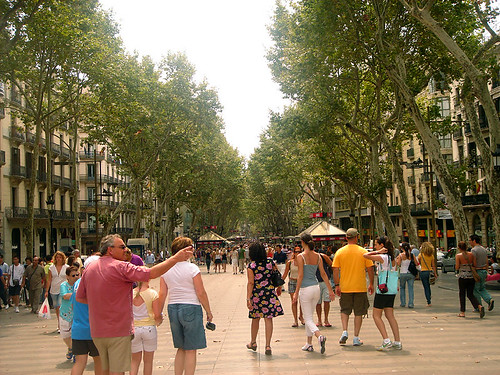
La Rambla is a pulsing tree-lined boulevard that runs right down the centre of the city and is an excellent example of how pedestrians rule the Spanish streets. As you can see, people occupy more than 70% of this major urban artery, while cars are relegated to a measly single-lane on either side of the walkway.
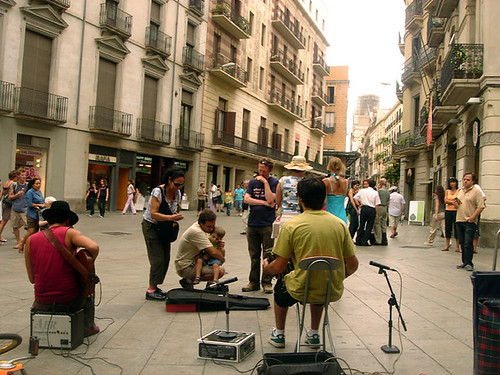
Throughout Barcelona, public streets are as much avenues for artistic discovery as they are pathways to beautiful buildings and Medieval alleyways. One thing that really struck me was the degree to which every neighbourhood seemed to have its own soundtrack, with buskers playing on every street corner. It was also refreshing to see artists’ colourful paintings littering the city’s sidewalks rather than vendors pawning off cheap Fendi knock-offs and weird blinking plastic toys.

Another thing I admired was how even the most practical street furniture had so much visual integrity. This simple car barrier, for example, was playfully transformed into a piece of art. Rather than using a series of metal polls to bar vehicles from entering this pedestrian-only area (something that we have yet to see happen in Toronto), planners decided to spell out “BARCELONA†with bronze statues.
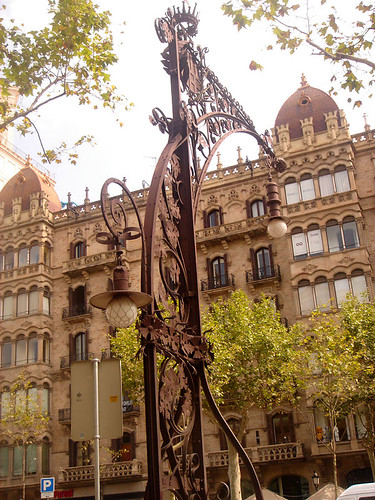
Another great example of this was how street lamps throughout the city were designed based on neighbourhood and architectural period (so as not to clash with the histories and cultures of the various urban areas).
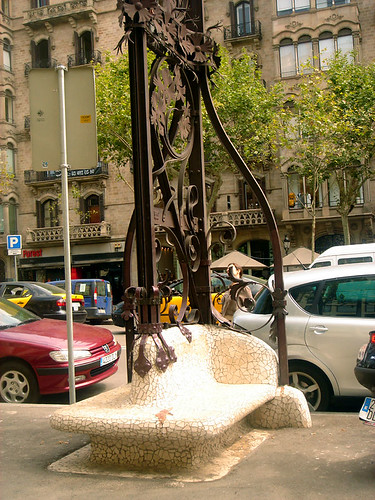
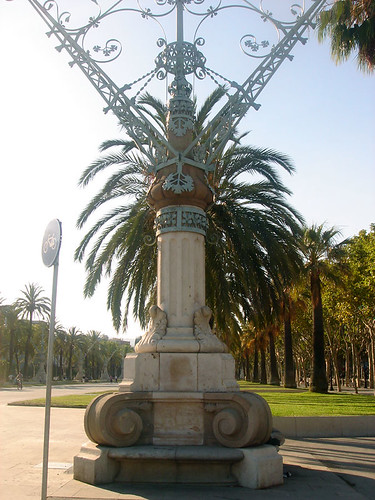
These lampposts were also designed to benefit pedestrians in that each one simultaneously functioned as a public bench. (As a side note, the bench on top was equipped with a hatch intended to be filled with coal . . . historical public seat warmers, what an idea!)

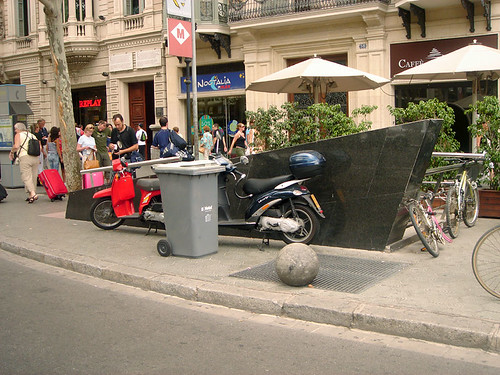
The public transportation system in Barcelona has also gotten on the aesthetic bandwagon. Every subway stop was unique and each design was seamlessly integrated into its surroundings.
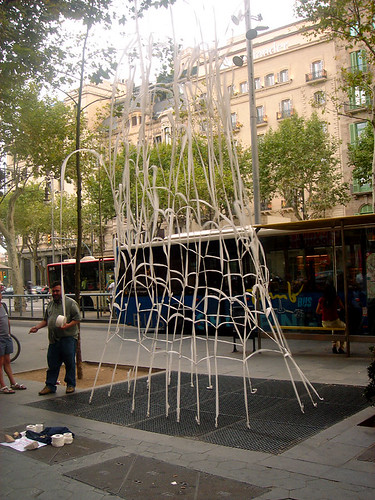
Even their vents and track systems were beautiful. Here, a local artist had created a spider-web of silk ribbons that floated and dipped as air from the underground tunnels was released to the street’s surface.
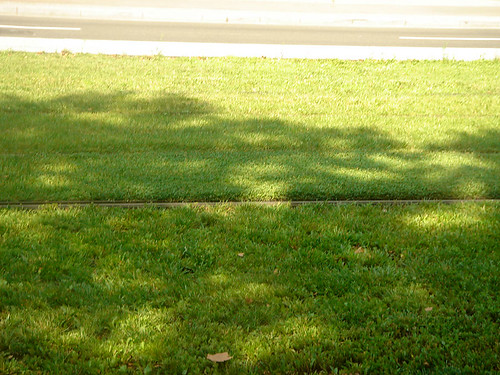
And, it’s amazing how a little grass can make streetcar tracks almost completely disappear.

Streetscape aside, one of the best things I found in Barcelona was Bicing: a city supported bike-share program that costs only €6 (approx. $9) per year. Using a swipe card and PIN, users are able to borrow bikes from one of ten Bike Stations around the city. Borrowing a bicycle is free for up to 30 minutes and there is a two-hour maximum, with a penalty of €3 (approx. $4.50) per hour if you go past the allotted time period.
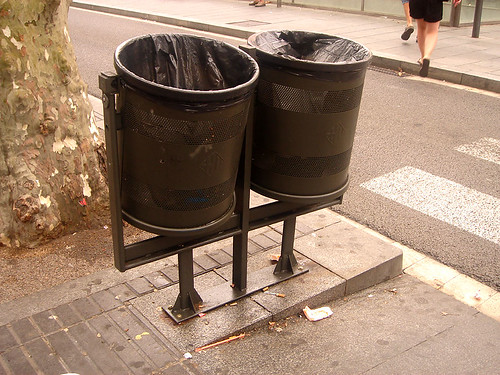
And finally, just because we at Spacing are garbage-can-obsessed, here’s a standard-issue Barcelonian garbage can.

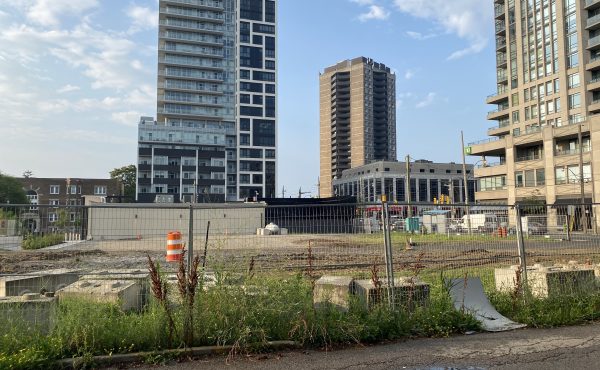
24 comments
Very cool! La Rambla is such a grand street. I’d heard that grass around streetcar tracks like that can also significantly dampen noise??
I have been to Barcelona and it is an amazing city.
I think that if more people in the GTA had more than 2 weeks of vacation a year they would be able to travel more often and see what is being done out there. My opinion of one of the reasons Toronto is so behind is due to the simple fact that people have nothing to compare it to and to realize how badly things are done here when it comes to streetscape, arts, culture and urban planning.
Cities like Barcelona see art and beauty as a necessity, here it is seen as a frill, the latest example being the voices complaining about the LED lighting in the CN Tower as a waste of money. If an artist did the spider web thing here he would probably get chased away just like the people chalking Dundas Square got chased by security.
Europeans love cars, they are simply smart enough to realize that it is not the way to go and hence public spaces like La Rambla. Here in Canada we are simply addicted to the automobile and can’t kick the habit no matter what and we get sprawl instead of beautiful public spaces.
>Another great example of this was how street lamps >throughout the city were designed based on >neighbourhood and architectural period (so as not to >clash with the histories and cultures of the various >urban areas).
Barcelona is a great city I agree. I couldn’t disagree with this sentiment any more though. I detest the notion that new design needs to be contextual, a little dissonance in the city never hurt anyone.
How can a new street lamp “clash” with an old neighbourhood? That attitude is just misplaced nostalgia and BS sentimentalism if you ask me.
The above attitude is the way my mom would talk about the pattern on a couch not matching the wallpaper.
Dude, you’re dissing your mom on the internet! You’re supposed to do that to other people’s moms.
I agree with the dissonance though — it is what I like about Toronto. I think that’s actually our aesthetic. Victorian by International Style skyscraper by PoMo pile by hot concrete brutalism by 2nd Empire house.
Where are all Barcelona’s utility wires? I thought that most cities had rough-hewn tree trunks with forests of wires hanging off them on every street.
Sorry, pet peeve.
Errr.. Barcelona’s Momma?
I like urban clutter! I dislike “historical districts.” it is entirely possible to put good new design alongside good old design.
Yeehaw!
I have been waiting for someone to mention the lighting on the CN Tower forever now. I’m still new to posting regularly on this site and wasn’t doing so when the lighting was first activated. This is a Barcelona thread so I’ll be brief.
The lighting on the CN Tower is an abomination, the designer of which took our greatest landmark and made it into a party favour devoid of grandeur or stature. Furthermore, the technology used is not suitable to the task (lighting is my business, so I have insight here) producing hollow colours and a foul pinkish white.
I think the tower should be lit, but it needs simplicity and elegance not some Shanghai knockoff job. A simple, bright white treatment (could still stay green with the proper LED equipment) that illuminates the ENTIRE tower would do what lighting is supposed to do: illuminate and accentuate the forms to which it is applied.
ON ANOTHER NOTE: I loved Barcelona and was blown away by their BCNeta program that saw everything from complex street cleaning machines to simple corn brooms used to keep the city in fine shape. La Rambla should be the inspiration for whatever we do on Queens Quay. Imagine a grand pedestrian mall with vendors and entertainment on the south side of the streetcar tracks. Cover the track in grass and we’ve got the best of all worlds.
Benches. One of my pet peeves is the lack of places to just sit and rest my feet or think about where I’m headed next or just to sit and watch. I suppose it’s another car-culture thing; if I had a car, that’s where I’d sit between stops.
Grass on tram lines. I saw this in Poland when I lived there.
Those trees on La Rambla are gorgeous. The way they soar so beautifully towards the sky, unlike our trees, spindly from neglect and abuse, should put our city works to shame.
Also, I rather like the integration of style. Some of those lampposts remind me of steampunk inventions, an aesthetic I really love.
I never had Barcelona on my ‘places to visit’ list but these pictures might have helped push it on.
Also, how old is La Rambla?
I ask this because the street perhaps pre-dates the car by centuries, so it was always a pedestrian friendly area, and when cars came around they made minor adjustments. I haven’t done much reading on this (perhaps a project for the day) but I’m sure this is the case in most European cities compared to most North American ones. Our cities developed in many cases along-side the car so there was no historical precedent for being pedestrian oriented. Instead we’re trying to force something that was never natural here (which I’m glad we are trying to force, because Toronto and most cities need a great pedestrian area).
It’s REALLY helpful to have folks share their thoughts and pics about the places they’ve visited – thanks an awful lot, and it helps mitigate any guilt that might be around about the carbon problems from flying.
Someone said about Toronto – “we’ve got the world but not the class” or was it being “world-crass” – but the point being we are quite a ways behind other places.
I’d like to know if there was any restricting of cars beside subway lines as a policy – I’d favour bikes of course, especially along Bloor, though University Ave. also needs a proper bike lane and that’d be simple to do too (just paint and oodles of room!) – but were the ped zones complementing transit?
Carlos hits the nail on the head — Torontonians are innocently but woefully ignorant of what happens in other cities, which leaves them trailing in the dust when it comes to civic improvements. For example, try telling people in Toronto that Dallas has great light-rail, or that Milwaukee has a new waterfront, or that St. Louis has a train to the airport. Unless they see it on TV, they have no idea. It would be fantastic if more articles like this could be posted on various cities, with a side-by-side photo shot of comparable sights in Toronto. Unless you really hammer people on head-to-head comparisons they just will not support politicians and leaders who try to implement such changes. Of course, you have to find visionary politicians and leaders to start with…
I wish we had something like bicing in Toronto. I like the little cargo rack on the front. That’s the bicing on the cake.
Of course council would probably love the idea, so long as the bikes were all plastered with ads.
While I generally agree that Barcelona is a great place (though hardly without faults), I do have some comments.
For example, This:
“Carlos hits the nail on the head  Torontonians are innocently but woefully ignorant of what happens in other cities, which leaves them trailing in the dust when it comes to civic improvements.”
Why do I hear this country bumpkin accusation so often? It doesn’t make any sense. Torontonians are THE most well-traveled people in all of Canada, and not just because we take more business trips than anyone else. And of course, almost half of us aren’t from here in the first place! This European prefers Toronto to most cities in Europe (true, I would live in London, if it wasn’t a Disneyland for the rich).
We live in a very dynamic and exciting city. It’s not perfect because the city is kept poor. Infrastructure is, in fact, generally terrible. Street level does need improvement. But, who, in Toronto thinks this is good enough??? Not a lot of people! Our fight for the ‘new deal’ is a fight for money–so that aesthetic and infrastructure improvements can happen. We can’t get those done when we’re half a billion dollars in the hole. It’s not that we don’t want to–it’s that nobody will do that work for free!
Now, having said all that, some (inner suburban) wards do elect officials that are small-town thinkers: the Minnan-Wongs of the city council. This DOES need to stop.
But generally, the problem we have does not stem from the city council. Let’s wake up, stop blaming the supposed bumpkins, and REALLY let our voice be heard about what we think about the artificial poverty this city is in… And I don’t mean, let’s bitch in this or that cafe about how we’re not treated right. We need rage!
Now:
“For example, try telling people in Toronto that Dallas has great light-rail, or that Milwaukee has a new waterfront, or that St. Louis has a train to the airport. Unless they see it on TV, they have no idea.”
Well, Dallas doesn’t have great light rail. DART is theoretically nice on paper, but it doubles up as regional rail (well, there is the TRE, but it’s hardly worth mentioning), as well as plain ol’ LRT. Due to Dallas’s geographic footprint, the 150 km of rail that it has are completely under capacity (60,000 daily ridership). It’s hard to say how the situation could be improved.
I don’t know much about Milwaukee’s waterfront or the St. Louis airport connection link, but I don’t see the point you’re trying to make–that people would not believe you about these things??? Strange, but certainly not my experience.
Finally:
“It would be fantastic if more articles like this could be posted on various cities, with a side-by-side photo shot of comparable sights in Toronto. Unless you really hammer people on head-to-head comparisons they just will not support politicians and leaders who try to implement such changes. Of course, you have to find visionary politicians and leaders to start with…”
How in the heck’s world would you do a side-by-side photo shoot of comprable sights? The idea is absurd because cities, for all the globalization, are still largely unique. There isn’t a Queen Street W in another city (any comparisons to SoHo are simply inappropriate), nor a Kensington, nor Cabbagetown, etc. etc. It’s not so simple.
I went to Barcelona a few years ago to visit family, and what struck me the most (besides the gorgeous and varied architecture, the vibrant streets and rich culture) was the fact that we didn’t drive anywhere, not even once! All three of my aunts had vehicles at home, but never used them during our stay. We walked everywhere and when walking to a certain destination was a bit too far, we took the subway.
Cars in Barcelona (and most other European cities) don’t dominate people’s lives like they do here, and that is directly related to how that city was built vs Toronto. I believe it’s also the main reason why people don’t seem as stressed and hurried there; living in a compact city built to a human scale is so much more sane and healthy than living in a sprawling, car-dominated city. Whenever I come home from a trip to Europe I quickly become dejected by the fact that Toronto is so woefully behind in these respects. It’s funny how so many Europeans came to Toronto in search of a better live, yet the cities in the countries they left are now so vastly superior to ours.
A bit of BCN context:
La Rambla is what you could consider the main street of Barcelona’s old city, the medieval section ‘below’ the Placa Catalunya, which the the main square. It’s very much tourist focussed–sort of an analogue to the Champs Elysées, although (in my opinion) much nicer!
‘Above’ Placa Catalunya La Rambla turns into Passeig de Gracia, which is the main street of the Eixample, basically the new city, built in the 1800s along the same lines as Haussman’s Paris. Passeig de Gracia, and other main avenues in the Eixample like the Avenguda Diagonal, are much more car-friendly as they are quite wide, although the enormous granite sidewalks and, often, lush central medians that are really more like parks put anything, and I really mean anything, in North America to shame from a streetscape POV.
From a non-rose-coloured perspective, it is worth noting that although BCN transit is very, very good the actual subway stations, as opposed to the entrances, are just as unremarkable as Toronto’s and a fair bit dirtier.
It’s a fantastic city–and absolutely worth being at the top of anyone’s European list. It’s worth remembering, though, that while Barcelona and some other places may make one depressed about Toronto (or our whole continent) we have some very different strengths. I mean, try finding decent Chinese food (or, rather, Xines) in Barcelona.
James: If you see the film Contested Streets, you’ll see that New York (Manhattan), to name one city, was laid out before the rise of the car. I would guess that this would be true for downtown cores of Toronto and many other North American cities, at least in the east.
GMD: Yes, of course most Eastern cities pre-dated the car. I should have said horse/buggy and car. With that in mind, I’m sure you can find exceptions. I’m just saying that most of the growth of our cities has came alongside the car, while many European cities due to their age grew without it, so to have pedestrian areas is more natural.
Cars verses Bikes verses Pedestrians: Legislation.
My friend D. mentioned that in some places in Europe, in a collision between an automobile and a bicycle, the larger vehicle is always at fault, unless explicitly proven otherwise, with stiff fines and potential loss of license.
This also applies to collisions of bicycles and pedestrians, without the loss of licence, but with stiff fines.
Perhaps this sort of flavour of legislation might make sense here, but I’m not holding onto my breathing pattern yet.
God, Toronto is unbearably UGLY!
Why is it so hard for us to actually implement good ideas that work elsewhere? Why are we SO PATHETIC, NARROW MINDED and UNIMAGINATIVE? It is fairly easy to implement many of these ideas, yet we are simply incapable of doing so.
Toronto is utterly and completely pathetic!
While I can sympathize with the frustration of Laba, to call us pathetic is certinaly an overstatement. If Toronto had 1,500 years of western civilization, we may have a city that could compete with Barcelona. But we have a city 200 years old, that grew up in the age of the automobile. We can’t change history, so we shouldn’t try to compare ourselves to the Euros. Let’s concede that do cities well, and North America has a long way to go.
But its hard to be apathetic city, as suggested, that keeps scoring top 10 livable city rankings. Yes, lots of work has to be done, but the attitude of Laba (just seems pissed off and offers no suggestions) is part of the problem.
wat a nice city
Barcelona is a 2000 years old and la rambla has about the same, becase la rambla is the ancient roman street around the disapier and old stonewall.
the people is very different about american people, more relax, the firearms are prohibited and only the policemen to be allow.
it´s with Milan the capital of design, and all street furniture are design for diferent designers.